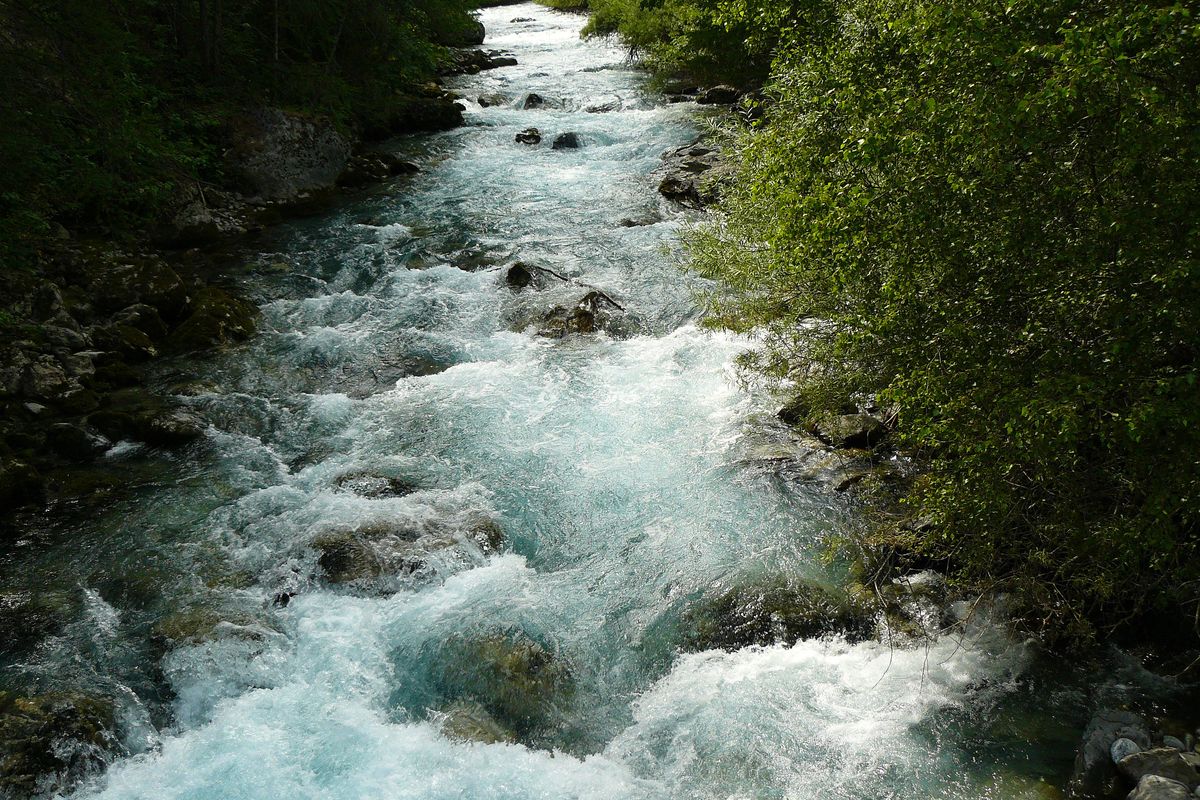
Biaysse P1 : from Pont des Oules to Freissinières
Description
The first section (P1) on the Biaysse offers two possible starting points : the first one, upstream of the bridge, allows the passage of three technical weirs, while the other start downstream of the bridge allows to avoid these passages which could be in bad conditions or dangerous. Aside from the first starting point option, the beginning of the section is quite peaceful (II-III), before the first rapids as soon as the river narrows. The first rapids are class IV. The follows a succession of rapids, with beautiful S and playfyl weirs. Some sections class III and IV take you up to Freissinières.If case be needed, the road is never to far which allows to desembark at any point along the river.
À l’approche de Freissinières, débarquer en rive gauche après le premier pont. Attention à l’infran (classe V) après le deuxième pont.
- Towns crossed : Freissinières
Gear
Helmet and life jacket are mandatory
Inflatable kayaks are not suitable and strongly advised against
Sensitive areas
Golden eagle
- Impacted practices:
- Aerial, , Vertical
- Sensitivity periods:
- JanFebMarAprMayJunJulAug
- Contact:
- Parc National des Écrins
Julien Charron
julien.charron@ecrins-parcnational.fr
Golden eagle
- Impacted practices:
- Aerial, , Vertical
- Sensitivity periods:
- JanFebMarAprMayJunJulAug
- Contact:
- Parc National des Écrins
Julien Charron
julien.charron@ecrins-parcnational.fr
Golden eagle
- Impacted practices:
- Aerial, , Vertical
- Sensitivity periods:
- JanFebMarAprMayJunJulAug
- Contact:
- Parc National des Écrins
Julien Charron
julien.charron@ecrins-parcnational.fr
Golden eagle
- Impacted practices:
- Aerial, , Vertical
- Sensitivity periods:
- JanFebMarAprMayJunJulAug
- Contact:
- Parc National des Écrins
Julien Charron
julien.charron@ecrins-parcnational.fr
Recommandations
- Approaching Freissinières, disembark on the left bank after the first bridge. Do not to go beyond the second bridge as there is a dangerous class V section downstream.
- Careful with floods after a storm
- Careful with logjams, especially at the beginning of the season
- Canyoning is authorized between 8:30 and 17:00 only, by municipal by-law
- Please take your trash with you
Attention : Experience is required in order to navigate these rivers without professional supervision. This information is provided for general guidance. Checking weather reports, water levels, flow rates and conditions before embarking is under your responsability. The tourism office and the national park will not be held responsable in case of an accident.
If you have doubts, please ask a professional. Kayak schools, instructors and renting shops of the valley are here to help you.
Mountain Rescue : dial 112
Weather report
Water levels at l’Argentière : https://www.rdbrmc.com/hydroreel2/station.php?codestation=1125
8 points of interest
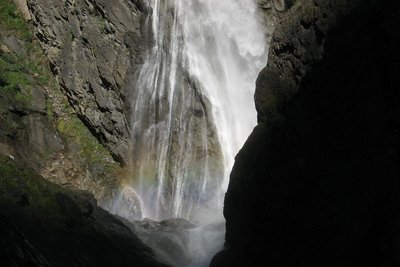
Cascade de Dormillouse - Thierry Maillet - PNE  Water
WaterDormillouse waterfall
The Biaysse valley from Fressinières to the Chichin valley has around 30 waterfalls. It is moreover a prime venue for ice climbing on falls in the winter. The impressive Dormillouse waterfall is part of this local heritage.
Coup d'œil sur Dormillouse en montant au Fangeas - Jean-Philippe Telmon - PNE  Panorama
PanoramaView of the village of Dormillouse
The village of Dormillouse is unique in that it is levelled into several hamlets, each of which has a public amenity. Enflous, at the bottom of the village, has the mill, Escleyers has the temple, the school and the fountain, and Romans, at the top of the village, has the oven. The stone and wood houses are typical of mountain architecture in an isolated area.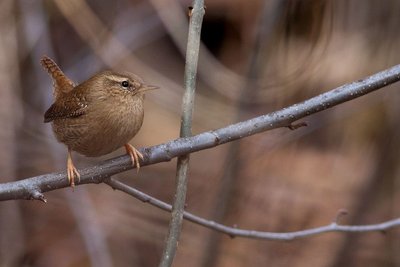
Un Troglodyte mignon saisi au repos - Pascal Saulay - PNE  Fauna
FaunaEurasian wren
This small 10 cm ball of feathers, with a white band across its eyes, is the “pétabouillou” ou la “pétouse” that lets out its powerful song from the branch it is on, tail oriented vertically. It fidgets continually in the clutter of vegetation, elusive.
 Water
WaterThe Oules stream
It has a series of waterfalls and natural basins that make it one of the most difficult streams to descend for those who like canyoning. The footpath that leads to the Fangeas lake follows it for most of the route and the sound of rushing water in the spring and the beginning of the summer, accompany the hiker.
 Archaeologie
ArchaeologieMines
A few remains of the exploitation of the ancient mine are disseminated around the sector of Fangeas. These mines go back to the Middle Ages, a period during which we exploited silver-lead and copper. It was a small exploitation, no doubt associated with the mines at Fournel. The metal mined was used to mint feudal currency. The mine works are now filled in and flooded, which has enabled us to find well preserved remains: scaffolding, turned wooden bowls, the sole of a shoe. Archeologists have been excavating the mine for the last ten years they started by siphoning off the flood water from the tunnels. The mines are not accessible to the public and we have deliberately not communicated their exact location. For more information about this heritage, contact the mining museum at l'Argentière la Bessée.
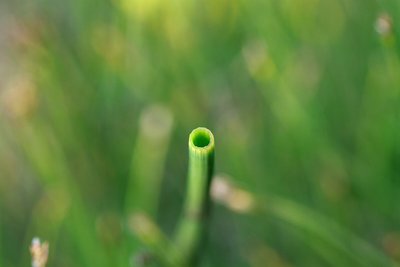
Section de feuille de prêle des rivières - Cédric Dentan - Parc national des Écrins  Flora
FloraThe horsetail
On the banks of a stream, on the edge of a ditch a plant grows which resembles a large bottle brush... or a horse's tail, depending on your imagination. It's the field horsetail, a plant related to ferns. It is known for its medicinal properties because it is rich in silica, a powerful remineraliser for the bones, cartilage and skin. There are several species of horsetail.
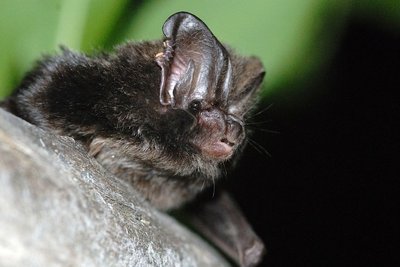
La barbastelle - Mireille Coulon - Parc national des Écrins  Fauna
FaunaThe barbastelle
In the village, birds build their nests in the old walls and bats live in the attics. Some hide behind shutters that are secured open against the walls. The barbastelle is a rare species of bat. Like all other bat species, it is protected. The hamlet of Le Ribes is privileged to be its home in the summer. This small mammal feeds on a large number of insects every night. It «moves house» frequently if it is disturbed or simply as a precaution.
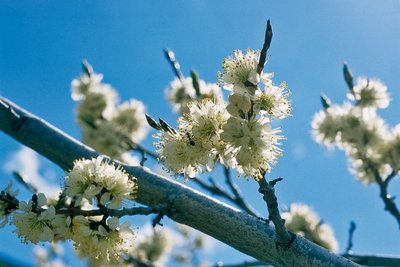
Prunier de Briançon - Bernard Nicollet - Parc national des Écrins  Flora
FloraHuile de marmotte - marmot oil
In times past, the inhabitants of Freissinières used oil for cooking and lighting. Walnut or almond oil was difficult to produce at this high altitude. The Briançon plum tree or marmottier, however, can withstand the mountain conditions, and the yellow fruits of this tree contain kernels. These kernels were pressed in mills to produce an oil with medicinal virtues: marmot oil. .
